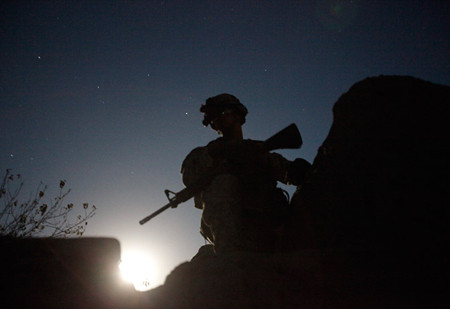By Jason Motlagh/Kabul and a TIME reporter/Loyi Rud
Night-time raids by Special Forces have become a mainstay of the U.S.-led war against the Taliban in Afghanistan, but they have turned much of the local population in the war zone against the Western presence. The conflicting narratives over what transpired in an Oct. 3 raid in the rugged farming hamlet of Loyi Rud, near the Pakistan border, is typical of the disconnect between the NATO mission and many of those it purports to protect. And that disconnect dims the prospects for success of the U.S. war strategy reaffirmed Thursday by the Obama Administration following a progress review.

A moonlit silhouette of a U.S. soldier from Charlie Company, First Battalion, 502nd Infantry Regiment of The 2nd Brigade Combat Team, 101 st Airborne Division is seen during a night foot patrol in West Now Ruzi village, district Panjwai, Afghanistan, late Sunday, Nov. 21, 2010. (Photo: Alexander Zemlianichenko / AP)
When area residents were jolted awake by an explosion late that Sunday, they assumed that foreign troops had come to destroy a local hashish factory. Outside their mud compounds, they saw the burning wreckage of a pick-up truck owned by a low-level drug smuggler. Soldiers moving through the hamlet dragged at least eight men, including the smuggler, from three compounds. And then, say locals and Afghan police officials, the operation took a wrong turn: In a fourth home, 28-year-old Nimatullah and his wife were lying in bed afraid, she claims,when several American soldiers crashed through their door, shouting over flashes of light and sharp, popping sounds that made her reach for her husband. He was already dead. "My clothes became wet with his blood," she says. "I pulled at his body and the soldiers were pulling me from him." The ordeal ended with her locked up in an adjacent room with her daughter and women relatives.
Western military officials tell a different story of that night's events. A statement by the NATO mission released the following day said intelligence reports had indicated that a Taliban operative smuggling weapons through the area was holed up in Loyi Rud. When a loudspeaker was used to call the suspect out of a compound, another man ran to a nearby building. He showed "hostile intent" when confronted, officials say,and was killed. The alleged Taliban facilitator was detained with several associates, who were said to be in possession of machine guns, grenades and 20 bags of wet opium. Lt. Col. John Dorrian, a spokesman for the NATO mission, flatly denies that coalition forces shot an innocent man in his bed. "We stand by the material in this release, which I verified through operational reporting channels," he says, adding: "It is understandable that rumors can get stretched after so much time goes by."
Military officials hail night raids as an effective tactic that has killed or captured hundreds of low to mid-level militant commanders, and they say that more than 80 percent of the time, not a single shot is fired. But critics, including the Afghan government, insist that costly mistakes are made with self-defeating regularity. A UN report released in August says that 41 civilians were killed in 13 raids during in the first half of 2010 — although it noted that because of limited reporting of such raids, many of them clandestine, the real civilian toll is likely much higher.
Last month President Hamid Karzai demanded an end to night raids, which he says alienate rural communities to the Taliban's benefit. (The demand was rejected.) Diplomatic cables released by WikiLeaks reveal that the Afghan president has been privately lobbying in vain against the tactic for almost two years. Over the same period, the frequency of night raids has reportedly grown fivefold, despite dire internal memos from State Department officials warning that civilian casualties would doom the U.S. mission in Afghanistan.
In Loyi Rud, the effects of the night raid appear to have alienated even the local law enforcement officials. Nimatullah, after all, had no prior criminal record, and was well known to neighbors and area police as a simple farmer who minded his own business. "The fact is that Nimatullah was just a farmer, not a Talib or a smuggler," says district governor Haji Abdul Ghani.The job of rooting out suspected Taliban or criminals, he argues, is best left to Afghan forces who have a better knowledge of local people and their affiliations.
U.S. military officials counter that while Afghan forces are usually included in the operations, tipping off local authorities, many of which are riddled with corruption, risks compromising operational security. But many Afghans have seen too many instances of innocent civilians being killed to accept NATO's explanations. Each incident no doubt has its own distinct story, but the pattern has made the prospects of the U.S. and its allies winning local hearts and minds increasingly improbable. After burying Nimatullah, about 60 Loyi Rud villagers traveled to the Spin Boldak district center to demonstrate against U.S. forces in their country. Several chanted "Death to America."
The aggressive tempo of Special Forces raids this year suggests that U.S. commanders believe that the tactical impact of eliminating local insurgent leaders outweighs the hearts-and-minds cost of the occasional mistake. But a senior U.S. officer who has commanded forces in Afghanistan maintains that a single lethal error has the power to drive an entire family or village irretrievably into enemy hands. "In the long term, building the relationship with the local community is more significant ... than killing any one local insurgent leader or commander," he says. After all, despite official boasts that a rising body count has handicapped the Taliban, the tenacity of the insurgency seems to suggest otherwise.
Published on: Dec. 16, 2010



